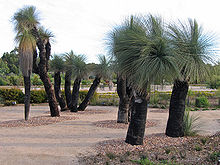
Back Dasypogonaceae AST Dazipoqonkimilər Azerbaijani Dasypogonaceae BS Dasipogonàcies Catalan Dasypogonaceae CEB Dasypogonaceae Czech Dasypogonaceae Danish Dasypogonaceae German Dazipogonacoj Esperanto Dasypogonaceae Spanish
| Dasypogonaceae | |
|---|---|

| |
| Kingia australis in the Royal Botanic Gardens, Cranbourne | |
| Scientific classification | |
| Kingdom: | Plantae |
| Clade: | Tracheophytes |
| Clade: | Angiosperms |
| Clade: | Monocots |
| Clade: | Commelinids |
| Order: | Arecales |
| Family: | Dasypogonaceae Dumort. |
| Genera | |
| |

| |
Dasypogonaceae is a family of flowering plants based on the type genus Dasypogon, one that has traditionally not been commonly recognized by taxonomists; the plants it contains were usually included in the family Xanthorrhoeaceae. If valid, Dasypogonaceae includes four genera with 16 species.[1] The family is endemic to Australia. The best known representative is Kingia australis.
The 2016 APG IV system places the family in the order Arecales, after several studies revealed the family as a sister taxon to Arecaceae, the palm family.[2] Other authors find that the placement of Dasypogonaceae remains undetermined, due to conflicting models, and leave it in an order of its own, the Dasypogonales.[3][4]
The earlier APG III (2009), APG II (2003), and the 1998 APG system all accepted the validity of the family, assigning it to the clade commelinids, but leaving it unplaced as to order.[5] The commelinids are monocots, the broad group to which, in any event, these plants clearly belong.
- ^ Christenhusz, M. J. M.; Byng, J. W. (2016). "The number of known plants species in the world and its annual increase". Phytotaxa. 261 (3): 201–217. doi:10.11646/phytotaxa.261.3.1.
- ^ Angiosperm Phylogeny Group (2016). "An update of the Angiosperm Phylogeny Group classification for the orders and families of flowering plants: APG IV". Botanical Journal of the Linnean Society. 181 (1): 1–20. doi:10.1111/boj.12385.
- ^ Givnish, Thomas J.; Zuluaga, Alejandro; Spalink, Daniel; Soto Gomez, Marybel; Lam, Vivienne K. Y.; Saarela, Jeffrey M.; Sass, Chodon; Iles, William J. D.; de Sousa, Danilo José Lima; Leebens-Mack, James; Chris Pires, J.; Zomlefer, Wendy B.; Gandolfo, Maria A.; Davis, Jerrold I.; Stevenson, Dennis W.; dePamphilis, Claude; Specht, Chelsea D.; Graham, Sean W.; Barrett, Craig F.; Ané, Cécile (November 2018), "Monocot plastid phylogenomics, timeline, net rates of species diversification, the power of multi-gene analyses, and a functional model for the origin of monocots", American Journal of Botany, 105 (11): 1888–1910, doi:10.1002/ajb2.1178, hdl:2027.42/146610, PMID 30368769
- ^ A.R., Zuntini; Carruthers, T.; Maurin, O; et al. (2024). "Phylogenomics and the rise of the angiosperms" (PDF). Nature. 629 (8013): 843–850. Bibcode:2024Natur.629..843Z. doi:10.1038/s41586-024-07324-0. PMC 11111409. PMID 38658746.
- ^ Angiosperm Phylogeny Group (2009). "An update of the Angiosperm Phylogeny Group classification for the orders and families of flowering plants: APG III". Botanical Journal of the Linnean Society. 161 (2): 105–121. doi:10.1111/j.1095-8339.2009.00996.x. hdl:10654/18083.